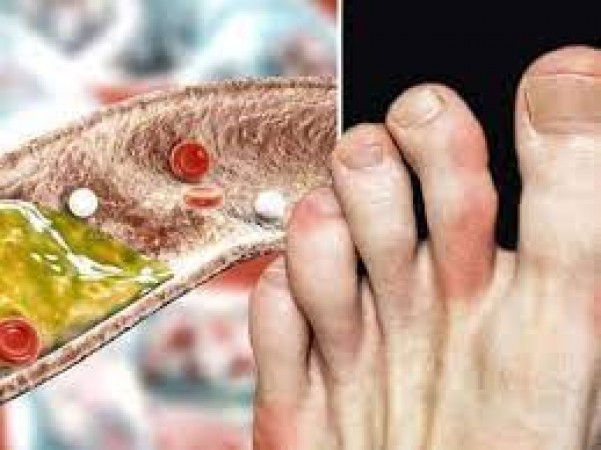
In our fast-paced lives, it's easy to overlook subtle signals that our bodies send us, and one such signal is a change in the color of the skin on our feet. Surprisingly, this can be a warning sign of high cholesterol levels, and understanding this connection is crucial for our overall health. In this article, we will delve into the intricacies of how changing skin color on the feet can be linked to high cholesterol and explore various symptoms associated with elevated cholesterol levels.
Our feet, often neglected, can serve as an early warning system for potential health problems. Changes in skin color, particularly on the feet, can be indicative of underlying issues, prompting us to pay closer attention to our overall well-being.
High cholesterol levels contribute to poor blood circulation, affecting the oxygen supply to various body parts, including the extremities. This, in turn, can manifest as changes in skin color, such as a bluish or yellowish tint. Understanding this link enables us to recognize the importance of monitoring our cholesterol levels.
While changes in skin color are a significant indicator, high cholesterol manifests itself in various ways throughout the body. Recognizing these symptoms is crucial for early intervention and effective management.
One of the classic symptoms of high cholesterol is chest pain or discomfort, often indicative of potential issues with the heart. It is a clear signal that demands immediate attention and further medical evaluation.
Difficulty breathing or shortness of breath may accompany high cholesterol, signaling potential cardiovascular complications. This symptom underscores the systemic impact of elevated lipid levels and the need for comprehensive healthcare.
Chronic headaches can be linked to high cholesterol levels, emphasizing the importance of considering cholesterol levels in the assessment of persistent health issues. Understanding this connection aids in the early identification and management of potential health risks.
Peripheral neuropathy, characterized by tingling sensations or numbness in the extremities, can be associated with prolonged high cholesterol. Recognizing this symptom highlights the need for regular health check-ups and cholesterol screenings.
Deposits of cholesterol can accumulate around the eyes, known as xanthelasma. This visible symptom not only affects physical appearance but also serves as a clear indication of elevated cholesterol levels, prompting individuals to seek medical advice and intervention.
A heart-healthy diet, rich in fruits, vegetables, and whole grains, can contribute significantly to lowering cholesterol levels and promoting overall cardiovascular health. Understanding the role of diet empowers individuals to make informed choices for their well-being.
Physical activity is a potent ally in the battle against high cholesterol. Even moderate exercise can significantly impact lipid profiles, emphasizing the importance of incorporating regular physical activity into our daily lives.
In cases where lifestyle changes aren't sufficient, medications prescribed by healthcare professionals can help control cholesterol levels effectively. Understanding the role of medication and adhering to prescribed treatments are vital components of cholesterol management.
Regular check-ups with cholesterol screenings are crucial, especially for individuals with a family history of high cholesterol or cardiovascular issues. These screenings provide valuable insights into an individual's health status and enable early detection of potential concerns.
Understanding your cholesterol levels empowers you to take proactive steps towards maintaining a healthy cardiovascular system. Regular monitoring and awareness of your cholesterol numbers enable you to make informed decisions about lifestyle and healthcare choices.
Dispelling common myths about cholesterol, particularly those related to diet, is essential for making informed lifestyle choices. Understanding the nuances of how dietary choices impact cholesterol levels helps individuals navigate towards healthier eating habits.
Understanding the distinction between HDL (good) and LDL (bad) cholesterol is pivotal for managing overall cholesterol levels effectively. This knowledge forms the basis for targeted interventions and lifestyle modifications to improve lipid profiles.
Addressing high cholesterol requires a holistic approach, encompassing diet, exercise, stress management, and regular medical check-ups. A comprehensive strategy ensures that individuals not only manage cholesterol levels but also promote overall well-being.
Simple lifestyle modifications, such as quitting smoking and moderating alcohol consumption, can significantly impact cholesterol levels. Recognizing the cumulative effect of small changes emphasizes the importance of making sustainable choices for long-term health.
Knowledge is the first step toward prevention. Raising awareness about the link between skin color changes and high cholesterol is vital for public health. This information empowers individuals to recognize potential warning signs and take proactive measures towards a healthier lifestyle.
In the symphony of daily life, our bodies often send out subtle melodies, alerting us to potential health concerns. Changes in skin color on the feet can be one such melody, signaling the need for attention to our cholesterol levels. By recognizing these signals and adopting a proactive approach, we can harmonize our health for a vibrant and fulfilling life.
Pakistan Secures Vice Chair Post at UNESCO, Defeating India by 10 Votes
Indian Diaspora in Dubai Extends a Warm Welcome to PM Modi at COP28 Summit